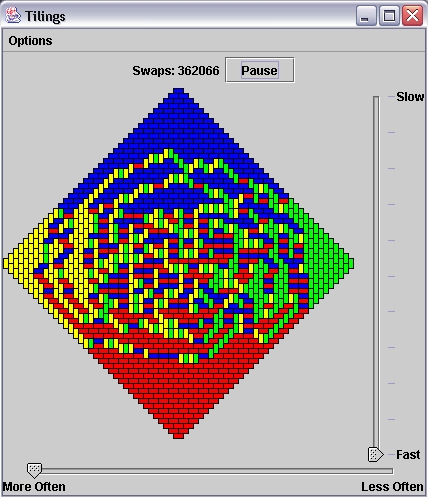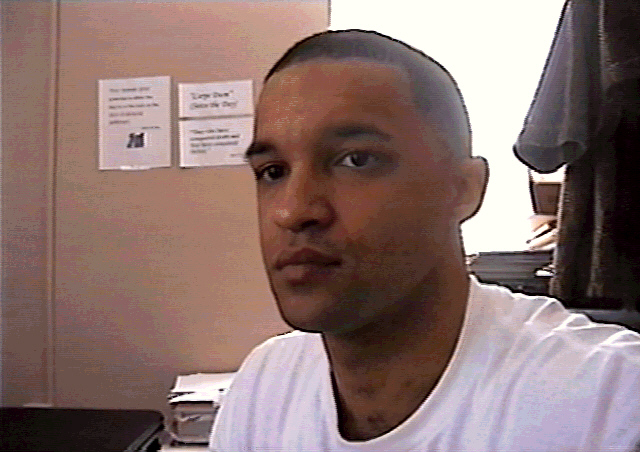VIGRE/GT REU Summer 2004
| Summer 2004 GT REUs | ||
| Professor | Student | Topic |
| Robin Thomas | Matt Perry | Topics in Graph Theory |
| Mason Porter, Bunimovich | Julie Bjornstad Alexie Dachevski | Mathematical Biology (See Below) |
| Hou Min Zhow | Robert Pruvenok | Image Processing |
| Shui Nee Chow | Caroline Seabrook Stephanie Chung | Pattern Formation |
| Ernie Croot | Bayazid Sarkar | Fermat Numbers |
| Dana Randall | Brittany Hughes | Markov Chains |
| John McCuan | Jeffrey Elms | Soap Films in Corners |
 Brittany Hughes: "The Effects of Boundry Conditions on Convergence Rates of Markov Chains"
As an introduction to Markov Chains, I will study tilings of a N x N chess board. As the summer progresses, I will
move onto perfect matchings on the square octogon lattice. I will also be studying how changing the boundry of a
lattice will alter the mixing speed of a Markov Chain.
Brittany Hughes: "The Effects of Boundry Conditions on Convergence Rates of Markov Chains"
As an introduction to Markov Chains, I will study tilings of a N x N chess board. As the summer progresses, I will
move onto perfect matchings on the square octogon lattice. I will also be studying how changing the boundry of a
lattice will alter the mixing speed of a Markov Chain.
Description: Theoretical ecology has a long mathematical tradition going back to Lotka and Volterra's predator-prey models. The student who undertakes this project will study a (3-species) food chain in phytoplankton with seasonal variation. (This generalizes recent work by Prof. Klausmeier and his collaborators.)
VIGRE/GT REU Summer 2003
 Aug 14, 2003: Check back soon for a more detailed report about
the REU activities this past summer. The range of activities, and their accomplishments,
is, I think, impressive.
Aug 14, 2003: Check back soon for a more detailed report about
the REU activities this past summer. The range of activities, and their accomplishments,
is, I think, impressive.
| Summer 2003 GT REUs | ||
| Professor | Student | Topic |
| Robin Thomas | Michael Abraham | Topics in Graph Theory |
| Professor Mucha | Casey Warmbrand | Political Network Theory |
| Professor Mucha | Thomas Callaghan | Football Network Theory |
| Shui-Nee Chow and Mason Porter (Use email to contact Professor Porter.) | Jeremy Corbett | Numerical Work in Spatial Temporal Chaos. |
| Mason Porter | Steven Lansel | Computer Simulation of Billiard Systems |
| Michael Lacey | Brandon Luders, Alex Charis | Additive Number Theory |
February 2004 Update
Steven Lansel, directed by Mason Porter Quoting: My project deals with billiard systems. A billiard system consists of a closed shape inside which a point particle bounces around. The point particle always travels at the same speed and bounces off the barrier of the billiard table with its angle of incidence equal to its angle of reflection. Depending on the shape of the billiard table, chaos or chaotic regions may be present in the system.
I am writing a program to simulate billiard systems to be used a tool for anyone working on them. The user is able to either select a billiard table from a list of the most commonly studied tables or enter an arbitrary shape and initial conditions. The program calculates the path of the point particle and plots the data in configuration and phase space.
Steven has continued his project into the fall and spring terms, refining the simulations, especially in the length of the paths of the balls. The code and many pretty pictures are freely available.
Casey Warmbrand, directed by Peter Mucha (Casey is also working with the supervision of a political science prof.) Quoting: I've been researching the network properties of the House of Representatives. Ive taken data for the past 8 congresses and created adjacency matrices. We have three types of matrices, one that contains congressmen and committees as the nodes, and a connection is defined between a person and committee if they serve on the committee, this type of network is bipartite. The other two types are projections of the first, one is people to people who are connected if they share a committee with the person, the other is committee to committee.
We've calculated a lot of basic network statistics; shortest/average path length, clustering coefficients, degree distributions and diameters. We've also created a community structure for each of the projections. The next things to look at will be, the removal of the subcommittees and taking the graph to only contain all the congressmen and the 19 standing committees, and recomputing some of the already calculated statistics and seeing what changes and if any trends are more readily apparent.
Attached is community structure of the committees (people are removed and disconnections are shown), also a nice trend is apparent in the degree distribution of the past 5 congresses (since the republicans took power).
Casey Warmbrand worked on his senior project on fractals in the Fall 2003 semester. In the spring semester, he has been one of three GT people in Budapest, studying math and computer science. The others are fellow GT undergrad David Eger, and the third is Adam Marcus, who will start graduate school at GT in the Fall 2004 semester.
Thomas Callaghan, directed by Peter Mucha Quoting: My REU titled "Football Network Theory" has been an examination of the current ranking schemes used for football and other sports and then the development of a simple yet innovative new scheme which takes into account the network properties inherent in the college football season. In addition to developing and examining our new system, I have also examined many different properties of the graph created by a college football schedule where teams are represented by vertices and games between two teams are represented by edges connecting the two vertices. Some of these properties include connectedness, clustering, community structure, betweenness, degree distribution, diameter, and the "small world'' phenomenon.
Go to the Directory Ring.jpg is simply a visual of the college football graph. Commstruct.jpg is a visual of the community structure of the graph generated using the latest community structure algorithm. If you closely examine, you will notice that it accurately places teams in the same conference together. The last file is a ranking of the NCAA Division IA football teams in 1990 (the last year Georgia Tech won the National Championship).
Thomas Callaghan has been continuing his work on this project into the Fall and Spring semesters. The article describing the particulars of this work is at the arXiv . The appearance of the article attracted attention from ESPN, Nature Online, the Chronicle of Higher Education. An article for the Notices of the American Mathematical Society is in preparation.
Brandon Luders, directed by Michael Lacey is developing some random models for Pollard's rho method for factoring. This delightful method, has a heuristic expected running time that is the square root of the smallest prime factor of the integer one is seeking to factor. The goal is to find some good probabilistic models for this method, and find a good estimate for the standard deviation of the running time.
Brandon Luders also continued his research topic into the Fall semester. He carried out extensive computations on the mean and standard deviation of the Pollard rho method. He discovered an anomalous deviation of the method from expected behaviors in a certain range of primes. His calculations conclusively show that the standard deviations are rather big, essentially as big as possible. An article should appear at the arXiv soon.
Alex Charis (a University of Toronto student) spent the summer investigating some aspects of number theory in both a computational and theoretical fashion. The questions pertained to the existence of certain presumably very rare primes. He has a nice report on his activities here.
Jessica Snyder worked on a problem in mathematical biology, specifically, a dynamical system model for some aspects of bipolar disorder, and in particular the effects of medication on the disease. This continued an ongoing research project of Mason Porter. Jessica Snyder reported on this project at the Dynamical Days meeting in January. The paper attracted a nice bit of attention, due to the novelty the approach.
Andrew Stimpson worked in an area of topology with a relation to the Hairy Ball theorem, and a very strong combinatorial aspect. He has a 12 page report on the subject, with an impressive array of figures in it.
Jeremy Corbett worked in the area of pattern formation in the solutions of partial differential equations. The physical model is a familiar one, if you take some sand in a box, and shake it rhthmyically, the sand will fall into some sort of pattern. The physics and mathematics of the problem is very interesting. And Jeremy Corbett spent the summer studying one research paper in the subject, and through the simulations, creating some very nice graphics that appear at differnt points in this web site.
He was joined by high school student A Behram who started at MIT in Fall 2004.
Ryan Hynd, not in the REU program, is in Leipzig Germany this summer, studying issues related to capillary surfaces. He and Professor McCuan have recent completed a paper on Rolling Curves, which grew out of last summer's investigations and experiments on Plateau's rolling drops. You can see movies of the same at the ACE Lab site. Ryan reported these results at a Sigma Xi conference in Los Angeles in December 2003.
Derrick Coetzee (not in the REU program) has written a program to turn Professor Belinfante's automatically generated proofs into humanly readable LaTex Output. The Lisp code is freely availible.
Blair Dowling directed by Dana Randall, is continuing the development of the stochastic model of the spread of HIV in the human body. This summer she is on the payroll of Emory Medical School. An abstract of a talk she gave at Microsoft Research on the subject.
Nathan Bell, directed by Peter Mucha is continuing to develop methods of simulating balls falling in an hour glass, and falling down a series of ramps. There are pics of 8000 balls falling down a series of ramps. Everything looks great. And is a fantastic job for his senior project. Check out the latest screen shots.
VIGRE/GT REU Summer 2002
The final report on the 2002 VIGRE/GT is availible.
 Ryan Hynd
Ryan Hynd  Joe Montgomery
Joe Montgomery